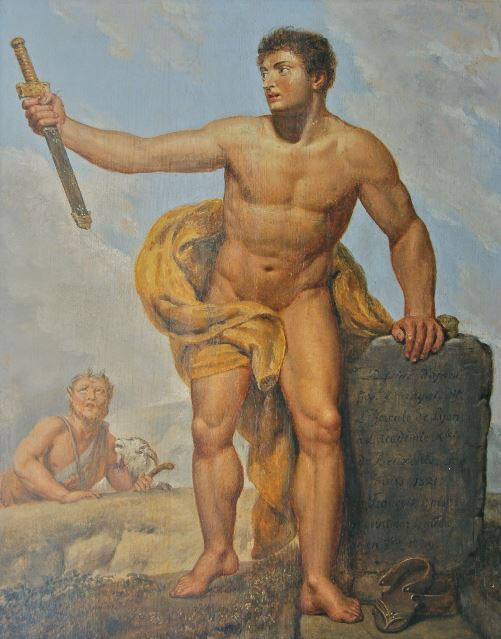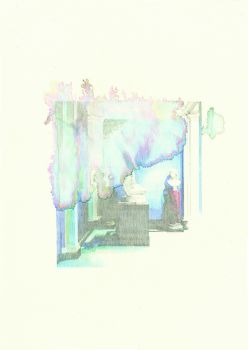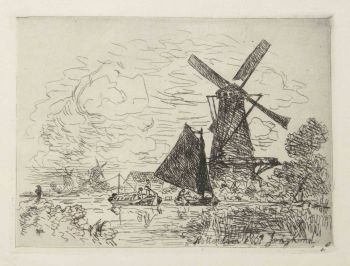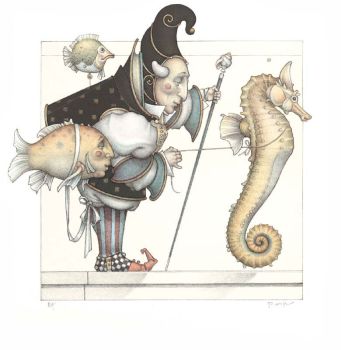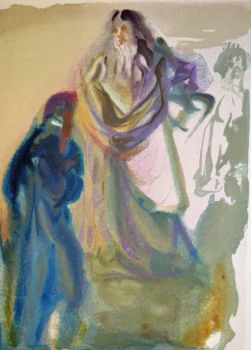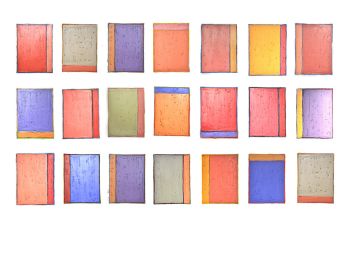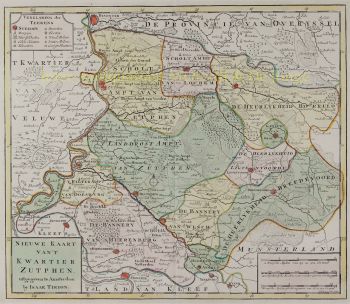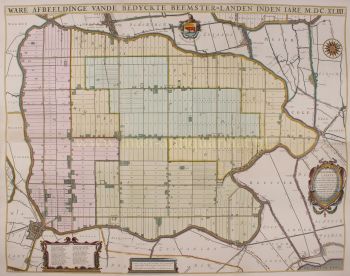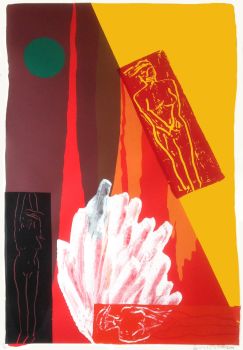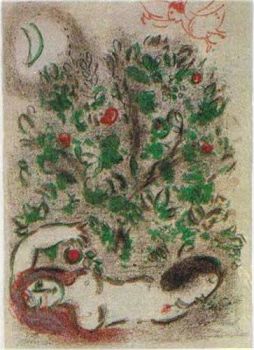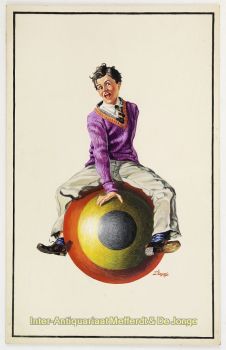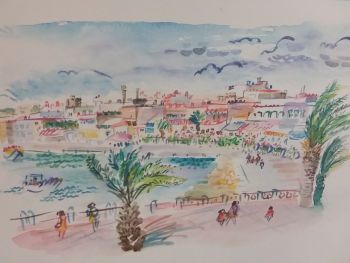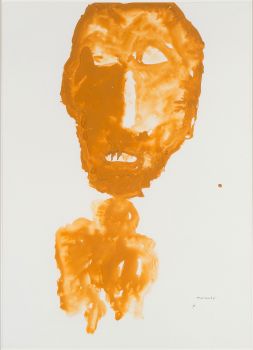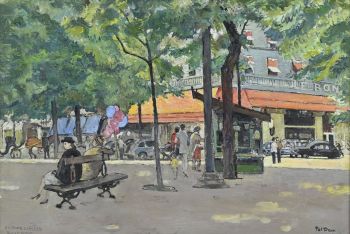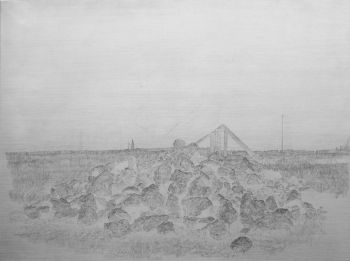Curated Curiosities: the story behind the engraving of Theseus and the slain Minotaur
Robert Schreuder is an art dealer who offers a broad range of works of art, mainly dating from the end of the 18th and the early 19th century - the era of neoclassicism and of the Directoire, Empire and Restauration - the successive, stately but very elegant styles in France between 1795 and 1830.
In particular, Schreuder is specialised in ‘Grand Tour’ objects: a visitor entering his charming gallery in Amsterdam might imagine he’s suddenly wandering around in Rome or Naples circa the year 1800, surrounded as he will find himself by marble, bronze and gilt statues, busts, models of temples, micromosaics, drawings of an erupting Vesuvius (a very fashionable subject in those days) and terracotta vases.
For collectors of so-called ‘Napoleontica’, Robert Schreuder is also absolutely worth a visit - “ça vaut le détour”. One of the many intriguing works of art offered by Schreuder is a stunning engraving (1787) of Greek hero Theseus, by the Italian master Raffaele Morghen.
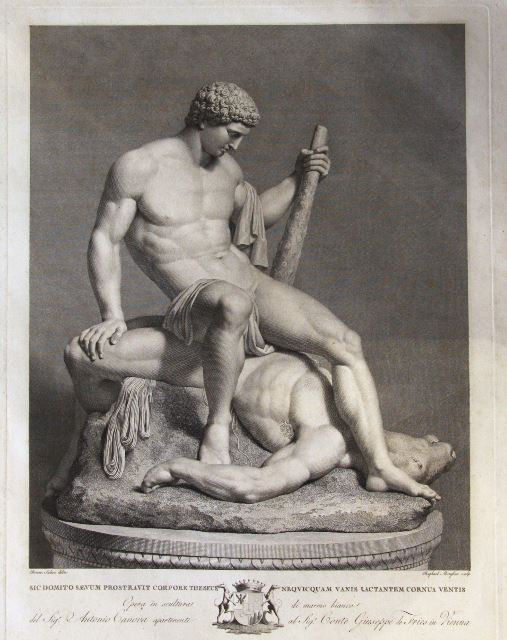
The superb engraving shows Theseus, mythical king of Athens, seated on the body of the conquered Minotaur,
after the statue by the world famous neoclassical sculptor Antonio Canova (1757-1822)
Theseus and the Minotaur
When Androgeos, the eldest son of King Minos of Crete, was murdered in Athens, the Cretan king, enraged and full of wroth, set sail to Athens with his army. Upon arrival, he asked Aegeus, king of Athens, to hand over the assassins of his son, in which case Athens would be spared. King Aegeus, unaware of the identity of the murderers, surrendered the whole town to the mercy of the infuriated king Minos.
Athens had to pay a gruesome and heavy retribution: each seven years, the seven most courageous youths and the seven most beautiful girls were to be boarded to Crete, where they were devoured by the Minotaur, a half-man, half-bull monster living in the Labyrinth. When Athens had to deliver its seven sons and seven daughters for the third time, Theseus, son of king Aegeos, decided to put an end to this atrocious and cruel horror. He took the place of one of the youths and set of with a black sail; if successful in slaying the Minotaur, he would return with a white sail.
After Theseus’ arrival in Crete, Ariadne, daughter of King Minos, fell in love with him and before entering the Labyrinth, she gave him a ball of thread, so he could find his way out of the Labyrinth again. Theseus tied one end of the string to door post of the entrance and eventually came to the heart of the Labyrinth, following Ariadne’s advice that Daedalus, who designed it, had given her. The Minotaur awoke and after a tremendous fight, Theseus vanquished the monster. After having the Minotaur decapitated, Theseus was able to escape from the Labyrinth using the string of rope and brought back the young Athenians, as well as Ariadne and her younger sister Phaedra.
Alas for the Cretan princesses: when they were all sleeping on the shore, the goddess Athena instructed Theseus to leave Ariadne (who would soon be comforted by the god Dionysos) and Phaedra behind. Distressed, Theseus sailed back to Athens, forgetting to change the black sail for a white one, upon which his father committed suicide presuming his son did not survive the Minotaur. King Aegeus threw himself into the sea, ever since known as the Aegean See.
Theseus by Pierre Joseph Célestin François
Canova's statue of Theseus and the Minotaur
Canova’s statue of the legendary Theseus executed in 1782-1783, is one of his earliest completed sculptures after his arrival in Rome in 1781. His patron, Girolamo Zulian (1730-1795), Venetian ambassador to the Holy See, gave Canova this massive block of marble, who was given a free choice of subject.
It was Gavin Hamilton (1723-1798), a friend of Canova, who advised him to portray Theseus after having slain the monstrous Minotaur. Theseus sits astride the Minotaur he has just slain, almost exhausted looking upon the dead body: Hamilton considered that a static group - a resting Theseus rather than a fierce fight between the hero and the monster - would gain Canova more favour and success.
The sculpture received widespread acclaim, and helped establish Canova’s reputation as the leading European sculptor of his day. When Canova finished this spectacular work in 1783, his patron Zulian was already appointed ambassador of Venice at the court of sultan Abdülhamid I in Constantinople and therefore gave the sculpture to Canova.
Canova sold Theseus and the Minotaur in 1786 to Joseph Franz Reichsgraf von Fries (1765-1788), who moved it to his palace (nowadays known as ‘Palais Pallavicini’) in Vienna.
Joseph von Fries - whose name is mentioned on the engraving, next to his coat of arms, as “Conte Giuseppe de Fries” - was the eldest son and heir of the astronomically wealthy Austrian banker Johann (von) Fries (1719-1785), ennobled (as a Freiherr or Baron) by Empress Maria Theresia in 1762 and created a Count of the Holy Roman Empire (Reichsgraf) in 1782.
The young Count von Fries was one of the greatest art collectors of his time and at his premature death at the age of only 23, his collection already consisted of more than three hundred paintings by world famous artists such as Rafael, Sir Anthony van Dyck, Rembrandt, Guido Reni and Albrecht Dürer, not to mention a vast collection of drawings, prints, sculptures - amongst others Canova’s Theseus and the Minotaur - and other ‘objets de goût et de vertu’.
In 1787, Joseph von Fries was portrayed by the celebrated Angelica Kauffmann (1741-1807), in those days one of the most fashionable portraitists. On the portrait, Canova’s statue of Theseus and the Minotaur, apparently a favourite of Von Fries (and he did have quite a choice...) is displayed in the background. Not surprisingly, Von Fries requested Raffaello Morghen - already renowned in Europe - to have the statue engraved.
Raffaello Morghen
Raffaello (also Raphael) Sanzio Morghen (1758-1833) was born in Portici near Naples as a son of the engraver (‘incisore’) Filippo Morghen and was given rather promising names: soon, Raffaello showed great artistic talent and in 1779, he became the pupil of the acclaimed Roman engraver (as well as excavator, dealer in antiquities and manufacturer of porcelain figurines) Giovanni Volpato (1735-1803), whose daughter Morghen eventually would marry. In 1782, Morghen was invited to Florence - the birthplace of his father - to engrave the various masterpieces in the Florentine Gallery and he was commissioned to engrave Leonardo da Vinci’s famous ‘Last Supper’ by the Grand Duke of Florence.
Soon, Morghen’s fame would extend all over Europe, being elected an associate of the ‘Institute de France’ in 1803 and in 1812, emperor Napoleon invited him to Paris. In “Italy, by Lady Morgan”, published in 1821, the Irish novelist Sydney Morgan née Owenson (1781-1859) - who visited Morghen in his atelier (“he good-naturedly threw aside his burin to accompany us through his gallery, and to point out, at our request, those of his works for which he had himself a preference”) - wrote in full sincerity and enthusiastically: “Raphael Morghen belongs already to posterity. (...) Raphael Morghen, like all persons of great genius, is simple, unaffected, and unpretending.” Morghen died in Florence in 1833; during his lifetime, he created over 200 compositions.
The first prints of Morghen’s engraving of Theseus and the slain Minotaur, of which the offered work is a fine example, were printed in Rome in 1787. Already by 1788 (“Memorie per le Belle Arti”, part IV, Roma, Stamperia Pagliarini), art critics praised Morghen’s engraving for its great refinement, in particular the use of lateral light thus provoking an impressive ‘chiaroscuro’ (‘clair obscur’) effect. According to his biographer Palmerini, the copper plate with Morghen’s incisions was bought by Domenico Artaria (1765-1823), a prominent Italian art dealer from Mannheim, who had it printed in Paris as well.
The text below the image reads: “Sic domito saevum prostravit corpore Theseus neqvicquam vanis iactantem cornua ventis”, a line derived from a poem (a so-called ‘epyllion’ or short epic story) by Roman poet Catullus, which can be translated as: “This is how Theseus, subdued in body, overthrew the ferocious beast, who threw up his horns, thrusting in vain at nothing but the empty wind”.
Underneath can be read: “Opera in scultura di marmo bianco del Sigr. Antonio Canova apartenente al Sigr. Conte Giuseppe de Fries in Vienna” (A sculpture in white marble by Antonio Canova belonging to Count Joseph von Fries in Vienna).
Lower left and right to the image, the engraving bears the inscriptions “Bona. Salesa delin.” (Bonaventura Salesa draw this image) and “Raphael Morghen sculp.” (Raphael Morghen engraved this image). The sheet size of the engraving is 52 by 72,5 cm, with plate margins of 38,6 by 51,1 cm.
Bonaventura Salesa
Even a great and endowed engraver has to rely on drawings, made after the original painting or statue. For instance, the drawing of the ‘Last Supper’ on which Morghen had to base his engraving - commissioned by the Florentine Grand Duke - was of less quality. The print, in consequence, was - although admirable - not really worthy of Da Vinci’s painting.
The preparatory drawing for this engraving however was a work by the talented draughtsman Bonaventura (also Buenaventura) Salesa (1756-1819). Salesa was born in Borja, a provincial town in Spain (Zaragoza) and entered the Academia de San Fernando in Madrid in 1770. After winning a contest in 1772, he was able to continue his studies at the Accademia di San Luca in Rome - that eternal and tempting city, always inviting to artists. In Rome, Salesa worked together with, amongst others, Morghen’s former tutor, the renowned Giovanni Volpato. By the end of the 18th century, Salesa returned to Spain, where he was appointed as “pintor de cámara honorario” (honorary court painter) of King Charles IV in 1799 and became a director (in the art of painting) of the Royal Academy of Arts of San Luis in Zaragoza in 1800, which position he maintained until his death in 1819.
Theseus’ whereabouts
Canova’s statue was later acquired by Charles William Vane Stewart (1778-1854), 3rd Marquess of Londonderry, British ambassador to Vienna from 1814 to 1823 - a man who, according to historians, was notorious in this court town for his rather loutish and lecherous behaviour. He probably bought it from Moritz Graf von Fries (1777-1826), brother of Joseph and in particular known as the great patron and benefactor of Ludwig van Beethoven.
The Marquess had Theseus and the Minotaur installed in Londonderry House, London (Mayfair). The contents of this aristocratic townhouse were sold in the 1960’s, prior to its demolition, and the statue was then acquired by the Victoria & Albert Museum, where it can still be admired.
The beauty and the intrinsic value of an engraving, like the one offered by art dealer Robert Schreuder, is first-rate and superb.
Typical for a print is the collaboration of several artists (sometimes successive, sometimes at the same time) and the various people who have been involved in the eventual creation of the engraving: in this case the sculptor (Canova), the draughtsman (Salesa), the engraver (Morghen) and last but most certainly not least the patron, who commissioned the work (Count von Fries). In a way, even the Venetian ambassador Girolamo Zulian can be considered a source, as the person who after all requested a statue from Canova in the first place.
To purchase an original statue by Canova - if ever on the market - is quite a challenge (the last Canova on the market, “The Three Graces”, was sold in 1994 for 7,5 million pounds and might easily fetch the tenfold nowadays), but for the relatively moderate price of 3.200 euro, one can purchase this absolutely excellent engraving, a work of art by a celebrated Italian engraver, commissioned by a renowned Austrian collector.
Only three copies of this engraving are known (amongst others in the collections of the Rijksmuseum in Amsterdam and the British Museum in London), so this is your chance to acquire not only neoclassical beauty of the utmost quality, but also a work of art with an illustrious history, all on a sheet of paper of 52 by 72,5 cm...
For more curated fine art also have a look at Gallerease!


